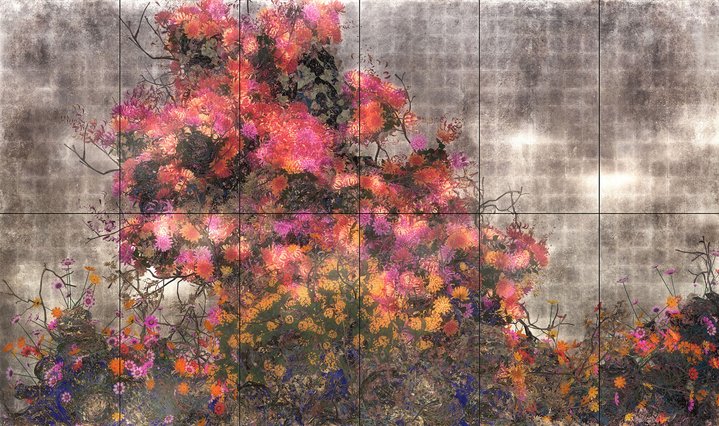Refik Anadol. Data Tunnel, 2020–2021. Video installation. Photo Anton Galetsky
In 2021 the Multimedia Art Museum, Moscow turned 25 and celebrated this anniversary with an ambitious project – the first international Biennale ‘Art for the Future’. With this show, the museum finally fully verifies its multimedia essence as stated in its title.
It is already the third biennale initiated and organized by Olga Sviblova, the energetic founder and permanent director of MAMM. The museum, initially called the Moscow House of Photography, opened at Ostozhenka in 1996 and launched a “Photo Biennale”. In 1999, there was another biennial project titled ‘Fashion and Style in Photography’ and, since then, every year, Moscow enjoys photographic festivals. In 2010, the building at Ostozhenka opened after a major reconstruction boasting around 9,000 square meters of new exhibition space over seven floors and, henceforth, this Guggenheim-inspired space adopted a new name: ‘Multimedia Art Museum, Moscow’. Its main focus has always been photography, although it has evolved over the past decade, showcasing in Moscow big contemporary art shows by international artists such as Marc Quinn, Joseph Koshuth, the Fluxus art group, AES+F, Recycle group, Ilya Kabakov, Electroboutique and others.
This new biennale comprises 60 projects, 23 of them by international artists from 12 countries with 16 participating artists being graduates from the prestigious Rodchenko School of Photography and Multimedia in Moscow. Among those taking part in the biennale are well known stars of contemporary art, such as teamLab art collective, Rafik Anadol, Adam Donovan & Katrin Hochschuh, Nonotak Studio, British artists Antony Gormley, Stanza, Ed Fornieles, Random International, Israeli artist and one of the pioneers of media art Michal Rovner. Russian artists include AES+F, Aristarkh Chernyshev (b. 1968), Pavel Pepperstein (b. 1966), ::vtol:: (Dmitry Morozov) (b. 1986), Rostan Tavasiev (b. 1986), Dmitry Kavka (b. 1974), Yulia Vergazova (b. 1987) and many others.
The exhibition occupies all seven floors of the museum and invites visitors on an adventurous journey through artistic reflections on Industry 4.0 technologies – virtual and augmented reality, neural networks, 3D, robotics, artificial intelligence, crypto world and other innovations, which have not only become a part of our daily life, but also have expanded artistic methods of expression. The Biennale demonstrates how different generations of artists think about the future and how their artistic approaches vary – from drawings, photography and video to more complex interactive installations requiring specific scientific knowledge and using state of the art technologies. The artworks on show are not categorized into thematic chapters, curators offer quite a winding narrative within which a viewer finds and follows broad topics such as techno biology, communication with non-human agents, space and time travels, post truth, chaos and order, dreams and anxiety.
Perhaps, there is one floor which creates a complete statement, a not so optimistic vision of the future, heralded at the entrance with a quote by George Orwell. The art gathered there looks like a warning about a possible ‘1984’ scenario: there is a big pink inflatable trampoline which looks like a cage (‘Network’ by Anna Rotaenko, b. 1990), megaphones (Vasily Yolshin), a wall of spruces made of barbed wire (‘Thicket’ by Sergey Shutov, b. 1955), a compilation of protest action videos, where a neural network distinguishes between protesters and police (‘Backlash’ by GreyCake artistic duo), interactive installation interpreting mechanisms of social control (‘Crowd Sign’ by Mikhail Maksimov, b. 1974) and AES+F’s latest video ‘Turandot’.
One of the highlights of the biennale is surely Antony Gormley’s VR installation ‘Lunatick’ (2019), created in collaboration with the astrophysicist Dr. Priyamvada Natarajan and produced by Daniel Birnbaum. Visitors wearing a VR headset can experience an immersive trip to the Moon, walking on its sculpturally recreated surface and feeling zero gravity. It is the artist’s first experiment with VR which is “the latest tool to extend our consciousness imaginatively beyond the limits of our bounding condition and realize our cosmic identity”.
Olga Sviblova has always looked into the future and sought various concepts of it in art. In 2007 and 2009, she curated the Russian pavilion projects at the Venice Biennale of contemporary art, the exhibitions were called ‘Click:’ ‘I hope’ and ‘Victory over the Future’. It seems that the emergence of ‘Art for the Future’ at MAMM was just a matter of time. The idea of the project appeared four years ago, but its opening in 2021 is accidentally tied up with the ‘Russian Year of Science and Technology’. “The most important is ahead, that is the motto under which we all should live,” she said in her inaugural speech. “Life is changing, art is changing as well and it tells us a lot about the future.”
The offline exhibition ‘Art for the Future’ is supplemented by the online exhibition of digital art and an educational program at www.artforthefuture.art. The parallel program will include exhibitions ‘Future Acceptance Laboratory’ and ‘Code of Art’ and an international symposium in March 2022.
Biennale ‘Art for the Future’
Multimedia Art Museum, Moscow (MAMM)
Moscow, Russia
December 21, 2021 – April 3, 2022















